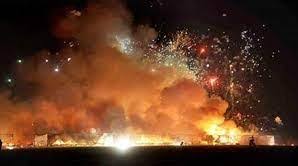
Diwali Air Pollution Surge in Delhi: PM2.5 Hits New Heights with Farm Fires, Traffic Additions
Delhi’s air quality saw a sharp deterioration on Diwali night in 2024, with Particulate Matter 2.5 (PM2.5) levels peaking at unprecedented levels due to a mix of firecracker emissions, traffic congestion, and intensified farm fires. PM2.5 concentrations rose 46% from October 28 to October 31, reaching a midnight peak of 603 µg/m³ on Diwali night—13% higher than previous Diwali highs in 2022 and 2023.
Record-Breaking Pollution Levels on Diwali Night
PM2.5 levels on Diwali night (from 8 PM to 8 AM) were 34% higher than those recorded on Diwali night in October 2022, increasing from 289 µg/m³ to 386 µg/m³. This year’s night-time PM2.5 levels were over twice the average pollution of the preceding seven nights.
Quick Build-Up and Dissipation
The Diwali air pollution pattern this year showed a rapid spike on Diwali night, followed by a quicker dissipation the following day. While PM2.5 levels reached severe levels around midnight on October 31, they began dropping significantly by the next morning, reaching a moderate 97 µg/m³ by noon. Unlike past years, this pollution spike didn’t persist for days, avoiding a prolonged smog episode.
Favorable Weather Aids Dissipation
The quicker clearing of pollution was largely attributed to warmer-than-usual October weather. Enhanced natural ventilation and steady winds prevented the pollution from lingering. However, a winter inversion is expected to worsen conditions in the coming months, likely leading to prolonged pollution episodes as temperatures drop.
Daytime Pollution Surges Due to Local Sources and Farm Fires
Interestingly, daytime PM2.5 levels on Diwali day were also notably high—92% higher than last year’s daytime average. The high levels were driven by a combination of increased local pollution sources and a sharp rise in farm fires in Punjab, Uttar Pradesh, and Haryana, with Punjab contributing 80% of the total farm fires. The IARI reported a surge in farm fires on October 31, jumping from 60 to 605 in just one day, amplifying the impact on Delhi’s air quality due to north-westerly winds carrying smoke into the city.
Diwali Night Pollution Hotspots
Pollution hotspots emerged across Delhi, exposing residents to dangerously high pollution levels. Out of 38 air quality monitoring stations, nine reported PM2.5 concentrations exceeding 900 µg/m³. Nehru Nagar saw the highest level at 994 µg/m³, followed closely by Anand Vihar, Pusa IMD, and Wazirpur, all recording levels around 980 µg/m³. Other impacted areas included Okhla, CRRI-Mathura Road, Karni Singh Stadium, Lodi Road, and Siri Fort.
Traffic-Driven NO2 Spikes on Diwali Night
In addition to PM2.5, Diwali night saw elevated nitrogen dioxide (NO2) levels due to increased traffic congestion. NO2 levels were consistently high across the nights leading up to Diwali, reflecting heightened traffic. The ITO area recorded the highest NO2 levels, with a night-time average of 182 µg/m³, while JLN Stadium and Patparganj saw averages of 104 µg/m³ and 101 µg/m³, respectively. In contrast, Lodi Road remained the least affected area, with just 2 µg/m³.
The Road Ahead: Addressing Local Pollution Sources
Despite a reduced impact from farm fire smoke, Delhi’s air quality deteriorated from “poor” to “very poor” largely due to local pollution sources, underscoring the need for rapid mitigation efforts. As Delhi heads into winter, experts warn that without aggressive action to curb local emissions, the city may face prolonged periods of poor air quality.